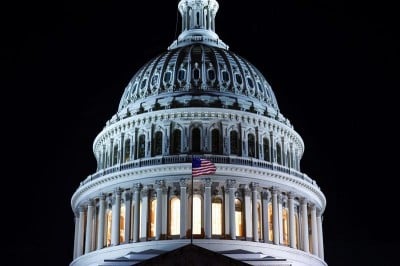
聽gece33 / Getty Images
The聽Federal Reserve聽has several tools that it uses to influence interest rates. As financial and economic changes occur, the Fed has to invent new ways to meet its dual mandate of maximum employment and price stability. One of the most important rates the Fed influences is the federal funds rate (FFR).
Below, we'll dive deeper into federal funds and the Fed's actions to adjust the fed funds rate, which indirectly controls many other interest rates and can impact you.
Key Takeaways
- Federal funds are the reserves kept by banks at one of the 12 regional Federal Reserve Banks. The Federal Open Market Committee (FOMC) sets a target for the fed funds rate year-round.
- Banks set their own interest rates when borrowing from other banks' reserve funds but stay within the target fed funds rate set by the Fed.
- The Fed heavily influences this rate using interest on reserve balances (IORB) and overnight reverse repurchase agreements (ON RRP).
How the Fed Convinces Banks to Change Their Rates
The Fed used to require banks to hold a certain percentage of their deposits in reserves at one of the 12 regional reserve banks each night. If they didn't have enough reserves, they could borrow what they needed. They were also paid interest on these reserves.
As of March 2020, banks are no longer required to hold any reserves. However, the Fed still pays interest on money the banks keep in reserve. The Fed calls this "interest on reserve balances" (IORB), giving banks an incentive to hold money in reserve.
Interest on Reserve Balances
The Fed can influence interest rate changes by changing the rate it pays interest on reserve balances. This sets the upper limit for the fed funds rate because banks won't want to borrow money at a higher rate than the upper limit of the FFR target range. Banks also would not be able to lend for more than this rate because the bank that needs to borrow money would simply go to the Fed's discount window and borrow directly from the Federal Reserve Bank.
Overnight Reverse Repurchases
The lower limit of the FFR is set using overnight reverse repurchase agreements (ON RRP). Many financial institutions do not hold reserves with the Fed, so it designed the ON RRP facility to give them an option to earn interest as well. This facility sells a bank a security and then buys it back the next day at a higher price. The buyback price is set by an interest rate, which becomes the lower limit of the fed funds rate range.
Effective Fed Funds Rate
Funds kept in reserve are called "federal funds." Banks charge interest rates when giving other banks overnight loans from these funds. The Fed sets a聽target聽range for the fed funds rate by setting the upper and lower limits, which banks then base their loans off. The Fed averages the interest rate banks charge each other overnight鈥攖his is the effective federal funds rate.
Adjusting the Rates
When the Fed wants to adjust interest rates, it moves the range set by IORB and ON RRP rates higher or lower. This causes the banks to raise or lower their interest rates correspondingly. In turn, these rates affect all other interest rates in the economy.
Note
The fed funds rate adjustments affect short-term interest rates, while open market operations affect long-term interest rates.
Open Market Operations
The Fed's buying or selling of securities (Treasury notes or mortgage-backed securities) from its member banks is called "open market operations" (OMO). In the past, this was used to influence the amount of reserves banks kept overnight.
The Fed uses two types of OMO鈥攑ermanent and temporary OMO鈥攖o help maintain "ample" reserves. Ample reserves are a tool the Fed uses to ensure there are enough reserves for dollar-funded markets to function smoothly.
Permanent OMO
The Fed uses permanent open market operations (buying and selling Treasuries, agency mortgage-backed securities, and agency commercial mortgage-backed securities) to reinvest principal payments from its holdings and roll over maturing Treasuries. It uses OMO to adjust two things: the overall size of reserves held by banks and the size or composition of its portfolio.
Temporary OMO
Temporary open market operations鈥攔epurchase agreements or reverse repurchase agreements鈥攁re used to address temporary fluctuations in the supply of reserves within the system.
Note
The Federal Reserve Bank of New York is the bank that conducts open market operations transactions.
Quantitative Easing
In general, QE lowers long-term interest rates (and bond yields) by decreasing the supply of government bonds on the market, forcing investors to place capital back into other investments like stocks. This is thought to help jump-start the economy by raising the price of stocks and stimulating consumer and business spending.
In 2008, QE increased the Fed's total assets to $2.3 trillion. By mid-2021, it topped $8.0 trillion, and in early 2022 it exceeds $8.8 trillion.
The chart below shows the relationship between total assets and total reserves from 2007 through 2021. It's important to note that the Fed's total assets include funds held in reserve.
Discount Rate
The Fed charges a discount rate to banks that borrow directly from its discount window. The Fed sets the discount rate higher or as high as the upper limit of the fed funds rate range because it prefers banks to borrow from each other. By doing so, the discount rate encourages banks only to use the discount window when necessary.
The chart below shows the changes in the discount rate and the effective federal funds rate since 2020.
Frequently Asked Questions (FAQs)
How do lower interest rates from the Fed affect mortgage rates?
When the Federal Reserve raises interest rates, it becomes more expensive for banks to borrow money. They pass those costs along to customers, and it becomes more expensive for consumers to borrow money from a bank, such as obtaining a mortgage. A higher interest rate from the Fed means higher interest rates on mortgages as well.
How often does the Fed raise or lower interest rates?
The Federal Open Market Committee, or FOMC, meets eight times per year. Members can decide in those meetings whether they will adjust the Fed's monetary policy, including raising or lowering interest rates. Whether they actually make any changes, though, depends on the current economic climate.






